Second Drive: 2011 Hyundai Sonata Hybrid

At some point, the minds at Hyundai got serious about the company’s mid-sized sedan game. Seemingly in a heartbeat, the Korean manufacturer went from being completely under the radar of the average American family sedan buyer to a viable alternative to default buys like the Honda Accord and Toyota Camry. That jump fell solely on the shoulders of the all-new 2011 Sonata, a sedan that has so far delivered the kind of styling, efficiency and low MSRP that sends consumers scrambling for their checkbook. But if you want to go the full distance in this segment, you had better come to the fight packing more than just a competent base model.
That’s something you don’t need to tell Hyundai. The company has shored up its Sonata line with a potent turbocharged 2.0-liter model designed to tango with V6-equipped competitors as well as the car you see above – a hybrid model that comes loaded with nearly all of the latest and greatest tech to keep fuel consumption at a minimum. Is it enough to put the Sonata Hybrid ahead of the electrified versions of the heavy hitters already prowling the scene? We took the wheel to find out.
Continue reading…
The mid-size hybrid segment is a funny little corner of the automotive world. Most of the players at this table are little more than standard sedans that have had their mechanical innards gutted and replaced with mutant internal combustion/electric motor mashups. From their exteriors, there’s generally been little to distinguish hybrid from V6 models other than wheel options and maybe a badge or two. But Hyundai has waded into somewhat uncharted waters by offering the hybrid version of the Sonata with bodywork that goes a long way toward separating the car from its siblings.
The keen-eyed out there are likely to pick up on a handful of small details that both add a bit of funky, slightly futuristic styling to the mix and help slim the vehicle’s shape as it cuts through the air. Up front, Hyundai’s designers and engineers worked together to come up with that slightly agape front fascia. There’s more than a little catfish in that hexagonal opening, but it serves the purpose of setting the Sonata Hybrid apart from the rest of the family. (Note, too, that the ‘bumper’ bar has been subtly altered from the model that debuted at the New York Auto Show). Additionally, LED daytime running lights grace the front headlights and the low-set fog lights now boast a stylish upkick that wraps around the front fascia.
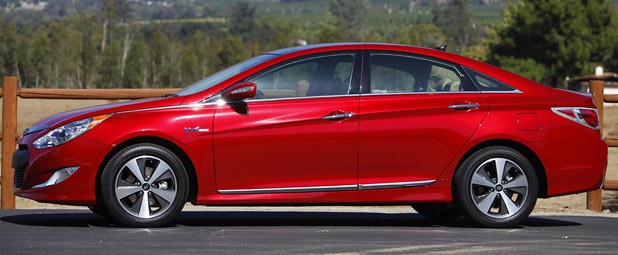
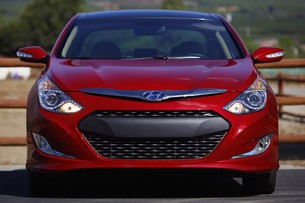
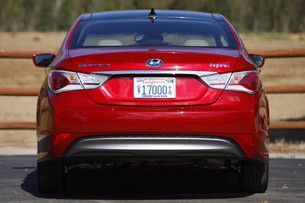
The profile of the 2011 Sonata Hybrid reverts to more well-established tricks of the mid-size hybrid trade, including re-sculpted side skirts and small but effective badges on the front fenders. Hyundai has also graced its hybrid with two unique wheel selections, a smaller 16-inch roller that shouts, “I’ll see you at Mac World,” and an optional, more attractive 17-inch five-spoke design like the one on our tester.
Move around back, and if you’re paying close attention, you’ll notice that the rear fascia is slightly squared-off on both sides. Those sharp edges help the Sonata Hybrid achieve its dizzyingly low .25 coefficient of drag. The standard Sonata makes do with a still enviable .28 cD. To complete the futuristic picture, Hyundai has also thrown in reworked taillights that are designed to evoke the image of an atom when lit.
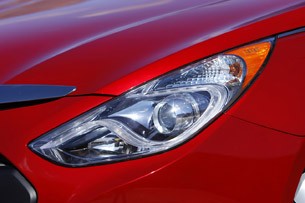
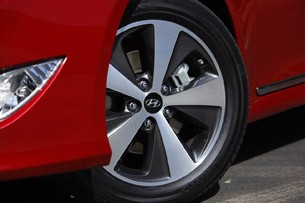
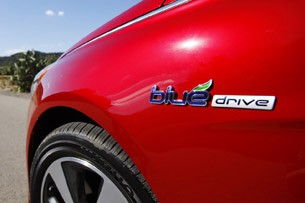
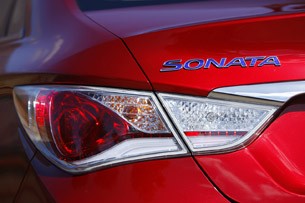
But as different as the exterior of the Sonata Hybrid is from its standard internal-combustion brethren, things have been left largely untouched inside. Buyers will still find the comfortable thrones, attractive dash and heaps of soft-touch goodies layered over almost every surface just like in the base Sonata. One difference between the base Sonata and the hybrid comes in the form of decreased trunk space. While the standard Sonata yields an EPA-rated cargo volume of 16.4 cubic feet, the compact battery pack soaks up a full 5.7 cubes all by itself. But the largest change comes at the instrument cluster, where a helpful full-color LCD screen delivers pertinent information on the vehicle’s battery state of charge, fuel economy and an “Eco Score.” Likewise, the left instrument bezel has forsaken the standard tachometer in favor of a helpful guide that lets drivers know when the vehicle can be driven in all-electric mode.
And when is that, exactly? Officially, Hyundai says that the Sonata Hybrid can cruise on all-electric go-go at speeds of up to 62 mph, though in our testing we saw electric-only driving at 65 mph under light acceleration downhill. and there was some indication from the company’s engineers that the car may be capable of doing even better. How do they do it? Under the hood, Hyundai has converted its 2.4-liter four-cylinder engine to the Atkinson Cycle and added a 40-horsepower electric motor. The duo is good for a combined 206 horsepower and 193 pound-feet of torque, but the real star of the show is the car’s battery pack.

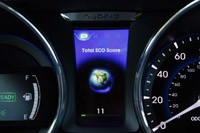
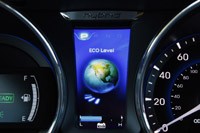
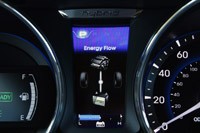
Instead of opting for the cheaper nickel-metal hydride cells used in cars like the Ford Fusion Hybrid, Toyota Camry Hybrid and Nissan Altima Hybrid, Hyundai has gone for costlier lithium-polymer cells. The company has crammed a total of 72 cells into the pack, each about the size of a cigar box lid and the weight of a roll of quarters. Throw in all of the necessary electronic wizardry to manage the LiPo goodies and a structure to support them, and you’re looking at a battery pack that weighs a relatively svelte 96 pounds.
Hyundai decided to opt for the more expensive battery cells for several reasons, the largest of which is the fact that the lithium-polymer pack weighs considerably less than other materials available right now. In addition, the automaker’s engineers note that the cells have no memory, generate less heat than comparable tech and take up less room. Unfortunately, the lithium-polymer tech is also expensive. Hyundai isn’t saying how much the company is shelling out for the battery pack in the Sonata Hybrid, but other automakers are looking to use lithium-based cells in their new vehicles, so the automaker is just riding the edge of the technological curve here.
Hyundai says that the Sonata Hybrid is good for 36 miles per gallon in the city and 40 mpg on the highway, and the high-tech battery pack is only a portion of that story. The company’s engineers have also rolled in a host of tricks to keep the fuel-economy numbers as high as possible, including what they call an “active air flap” behind that gaping hexagonal inlet in the front fascia. At low speeds, the flap is open to assist in cooling the gas engine, but once the vehicle speeds up, the flap closes to decrease the Sonata Hybrid’s coefficient of drag by as much as 10 percent.
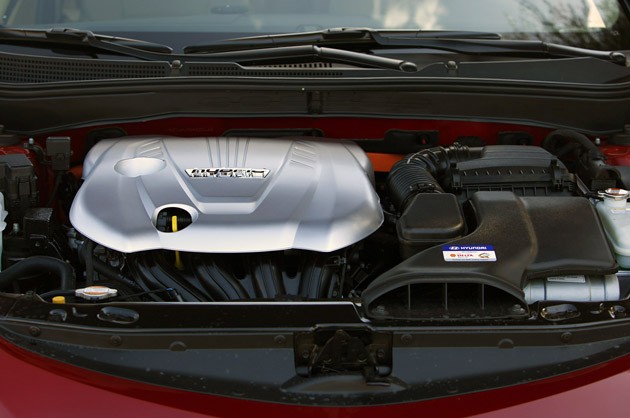
In addition, the sedan makes use of an engine clutch that can separate the gasoline engine from the electric motor, helping the hybrid to clip along on electric power even at highway speeds, all without using an ounce of fuel. Hyundai has also made the interesting step of shutting off the gasoline engine entirely when the vehicle decelerates, further conserving fuel and allowing the regenerative brakes to recharge the batteries.
And what does all of that translate into once on the road? During our time behind the wheel, we saw just over 36 mpg in intermittent stop and go driving, though if you’re ginger with the accelerator, numbers closer to 40 in combined driving weren’t unheard of among the gaggle of writers the company had out to sample the Sonata Hybrid. Just out of morbid curiosity, we spent the last 30 miles of our drive hypermiling the hybrid. When all was said and done, we walked away with a sweaty 60 mpg, further proving that by and large, fuel economy falls on the shoulders of the nut behind the wheel.
When you’re not treating the throttle like a hair trigger, the Sonata Hybrid rewards with a surprisingly normal driving experience. The run to 60 mph takes around 9.2 seconds, and thanks to the clutch separating the engine from the electric motor, transitions between internal combustion power and electric go-go are some of the most seamless in the industry. Part of the sensation that you’re driving a real vehicle and not some slot-car track escapee comes from the fact that Hyundai opted for the company’s proprietary six-speed automatic gearbox instead of a continuously variable transmission. Engineers may have been able to eek out a bit of additional fuel savings had it gone with a CVT, but selecting a conventional cogbox has gone a long way toward making this hybrid a more satisfying craft to pilot.
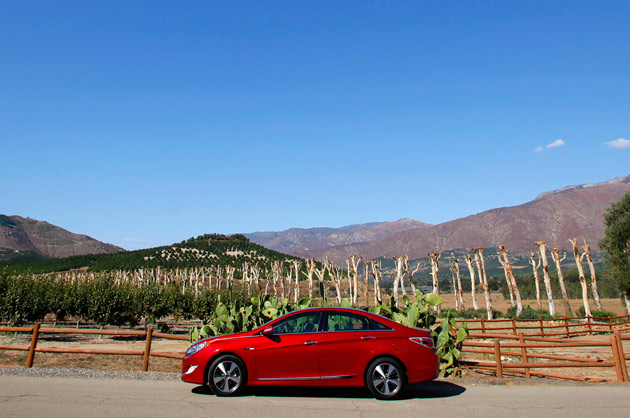
Impressively, despite the fact that this is Hyundai’s first shot at a production hybrid, the electrified Sonata successfully avoids one of the biggest pitfalls of throwing an electric motor into an otherwise solid chassis. The regenerative brakes are progressive and feel just like what we expect stoppers to feel like. There’s no danger of having your dental work ripped from your mouth thanks to an overly sensitive second pedal.
But that’s not to say that Hyundai hasn’t left room to grow in the Sonata Hybrid. Interestingly enough, the company chose to forsake forced-induction in favor of an updated version of its 2.4-liter mill. A little bit less displacement paired with a small turbo would probably help squeeze a few more mpgs out of this equation, but it undoubtedly would have swelled the per-unit cost on a model that’s unlikely to make any money to begin with.

Even with that shortcut under its belt, the 2011 Sonata Hybrid is an impressive first showing from Hyundai in the hybrid game. As it sits, the car is eligible for a $1,300 federal tax credit, at least for the first month it’s on sale. Hyundai says that buyers can snap up their own Sonata Hybrid starting this December, but unfortunately, the federal tax incentive program for hybrid vehicles is scheduled to dry up at the end of 2010, so interested parties would do well not to dawdle.
Hyundai hasn’t yet said how much we can expect to pay for its new hybrid four-door, nor what kind of warranty the model will carry when it does hit dealer lots. Given the company’s long history of providing copious content and an industry-beating warranty for reasonable money, we’re guessing that neither will be a point of contention when the car goes on sale. Even with those questions left blank, the 2011 Sonata Hybrid has proven itself more than capable of running with the rest of the mid-size hybrids. Is it the best of the breed? We’ll need some back-to-back time to know for sure.




